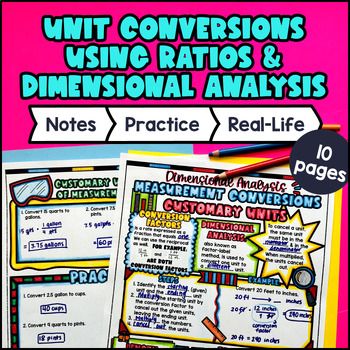Want more ideas and freebies?
Get my free resource library with digital & print activities—plus tips over email.
Join for Free Resources →
$4.25
Ever wondered how to teach measurement conversions in an engaging way to your 6th grade students?
In this lesson plan, students will learn about measurement conversions using ratios and dimensional analysis. Through artistic and interactive guided notes, check for understanding activities, a practice color by number worksheet, and a maze worksheet, students will gain a comprehensive understanding of measurement conversions.
The lesson culminates with a real-life application where students will read and write about real-life uses of unit conversions. Students will explore how measurement conversions are used in everyday situations, making the topic more relatable and applicable to their lives.

$4.25
After this lesson, students will be able to:
Before this lesson, students should be familiar with:
As a hook, ask students why measurement conversions are important in real-life situations. Refer to the last page of the guided notes as well as the FAQs below for ideas.
Use the first page of guided notes to introduce the concept of measurement conversions using ratios and dimensional analysis. Walk through the key points of how to convert between different units using ratios and conversion factors.
Based on student responses, reteach any concepts that students need extra help with. If your class has a wide range of proficiency levels, you can pull out students for reteaching, and have more advanced students begin working on the practice exercises.
Have students practice measurement conversions using ratios and dimensional analysis using the practice worksheet included in the resource (page 2 of guided notes). Walk around the classroom to answer any questions students may have.
Fast finishers can then work on the additional practice activities provided in the resource, such as the color by code or maze (page 3 and page 4 of guided notes). You can assign these activities as homework for the remainder of the class.
Use the last page of the guided notes to bring the class back together, and introduce the concept of real-life applications of unit conversions. Explain to students that unit conversions are not just useful in math class, but they are also used in many real-world scenarios.
Give examples of real-life situations where unit conversions are necessary, such as:
Encourage students to think about other situations where they may need to use unit conversions in their daily lives.
Refer to the FAQ section of the teaching resource for more ideas on how to incorporate real-life applications of unit conversions into your lesson.
If you’re looking for digital practice for measurement conversions, try the Pixel Art activity in Google Sheets. Every answer is automatically checked, and correct answers unlock parts of a mystery picture. It’s incredibly fun, and a powerful tool for differentiation.
Here's an activity to explore:
Dimensional analysis is a method used to convert between different units of measurement. It involves setting up conversion factors as ratios and canceling out units to arrive at the desired unit of measurement.
To convert units using ratios, you need to set up conversion factors that relate the units you are converting. Multiply the given measurement by the appropriate conversion factor to cancel out the old unit and introduce the new unit.
The guided notes in this lesson plan provide a structured format for students to learn and take notes on measurement conversions. They include explanations and examples to help students understand the concepts and processes involved.
Students can practice measurement conversions through various activities included in this lesson plan, such as coloring by code, solving mazes, and completing problem sets. These activities reinforce the understanding and application of measurement conversion skills.
This lesson plan includes a real-life application section where students can read and write about real-life uses of unit conversions. This allows students to see the relevance and practicality of measurement conversions in everyday life.
Get my free resource library with digital & print activities—plus tips over email.
Join for Free Resources →